My Back Hurts When I Deadlift. What Am I Doing Wrong?
The Deadlift.
It’s a powerhouse of an exercise that enhances almost every aspect of athletic performance. If you want to be bigger, stronger and faster, the Deadlift is an exercise that needs to be in your arsenal. However, mastering the form of the Deadlift takes time and practice. You’ll know pretty quickly if you deadlifted with poor form—for the next few days, your back will feel like it was on the wrong end of a sledgehammer. Deadlift-associated back pain is a common problem for many athletes, but it certainly shouldn’t turn you off from this excellent exercise for good. We will explain why your back might hurt after you deadlift and what you need to do to fix it.
The Posture Problem
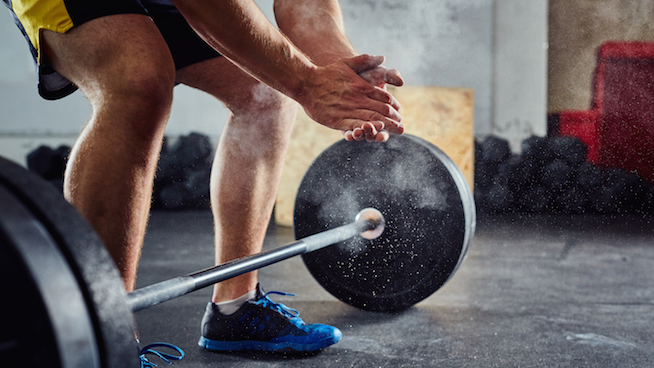
We’ve detailed the prevalence of posture issues in previous articles. One of the biggest issues, among both athletes and non-athletes, is what’s known as excessive anterior pelvic tilt. It’s a result of a lifestyle that hunches us forward (think looking down at your phone or driving a car) and training that builds muscle imbalances.
RELATED: Read How Your Posture Can Ruin Your Performance
“Over time, athletes can adopt an exaggerated posture where they go into what’s called excessive anterior pelvic tilt; their pelvis is rolled forward and their lower back is arched pretty hard. What that does is it decreases hip motion and increases spinal motion. When they try to get into a hip hinge pattern like a Deadlift, they move more through their back than their hips,” says Tony Bonvechio, CSCS and owner of Bonvec Strength. Excessive anterior pelvic tilt is a big reason why so many athletes struggle to nail the Deadlift right off the bat.
Excessive anterior pelvic tilt also makes it difficult for an athlete to execute a proper hip hinge, the motion that’s required for a safe, strong Deadlift. “The Deadlift is a novel exercise. Most athletes lack the proper hip hinge motion to do the movement at first,” says Tony Gentilcore, CSCS and the owner of CORE in Brookline, Massachussets.
Additionally, many athletes have trouble learning how to brace their anterior core muscles during an exercise—a key component of deadlifting. “A lot of athletes who come in with excessive anterior pelvic tilt, they’re basically bracing through the backside of their body. They’re stabilizing the body by using the muscles of the lower back,” Bonvechio says. While this pattern might not be noticeable in many other exercises, the Deadlift makes it painfully apparent.”
RELATED: How to Fix Back Rounding When Deadlifting
The Sight of Soreness
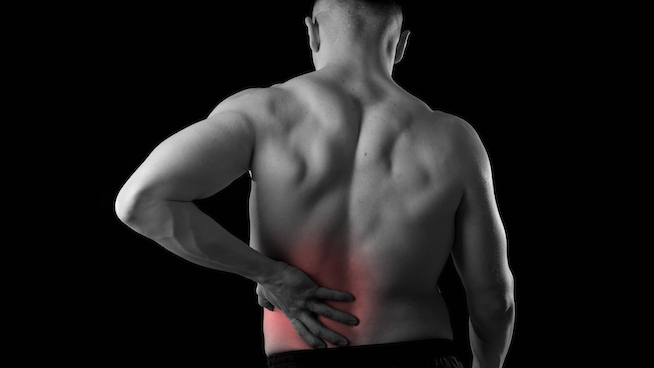
What does a back-hurting Deadlift look like? Though it can take many forms, significant arching throughout the spine is a telltale sign. This form issue can result from a variety of factors, including muscle imbalances and lifting too much weight.
“A lot of athletes might start in a good position, but when they try to lift the weight, they round their back. The spine does not like to be loaded in a flexed position. It doesn’t like to be loaded when it’s rounded. Think of like a rainbow or a candy cane, that’s usually what you see,” Bonvechio says. “Their spine can’t stay in the same position throughout the entire lift so it rounds, because that’s the path of least resistance.”
RELATED: Fix The 10 Most Common Deadlift Technique Mistakes
Sounds painful, right? Young athletes also typically overload the Deadlift too early, setting themselves up for failure. “I think a lot of kids, particularly in high school, are anxious to brag or show off on social media and they’re just using too much weight. That doesn’t allow them the opportunity to learn how to execute the lift correctly with a weight they can actually handle,” Gentilcore says.
So you’ve got a ton of athletes lifting with poor form and using too much weight. That puts a lot of stress on their lower backs and spinal discs, which can lead to injuries such as herniated discs. No wonder the Deadlift seems to do a number on so many people’s backs.
Very few people are capable of nailing a straight barbell Deadlift from the floor on their first try. That’s why regressions are a key component to building a proper Deadlift.
One Step Back, Two Steps Forward
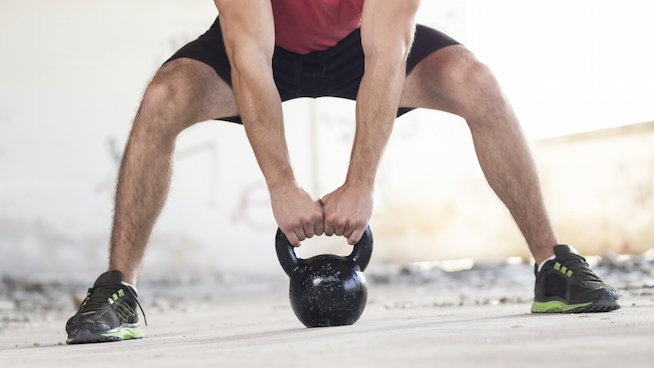
If you’re someone who frequently experiences back pain after you Deadlift, perhaps the best thing you can do is avoid the exercise for a while and do regressions in its place. Regressions are simpler, safer exercises that build the motor patterns and strength needed to execute a given exercise with proper form.
Dead Bugs can help you train your body to brace through your anterior core muscles. Bonvechio says, “Dead Bugs teach you how to get your ribcage down, how to get your pelvis in a neutral position and how to brace the right way. That’s a ground-based exercise, so it’s super simple.” Dead Bugs force you resist extension by bracing your core, which is exactly what you need when you deadlift.
RELATED: How to Do The Dead Bug, The Best Core Exercise You’ve Never Tried
Once you’ve mastered the Dead Bug, you can move on to standing exercises like Cable Pull-Throughs and Kettlebell Sumo Deadlifts. “Those exercises are also loaded a lot lighter than your typical barbell Deadlift, so even if an athlete doesn’t get it right the first time, the load is so light that it’s not detrimental,” Bonvechio says.
Once you’ve mastered these exercises, you can move on to variations like Rack Pulls and Trap Bar Deadlifts. These are a bit more user-friendly than straight bar Deadlifts from the ground. “A lot of times, a regression is a progression. If I can get an athlete to do the pattern pain-free, that’s progress,” Gentilcore says.
Right on Cue
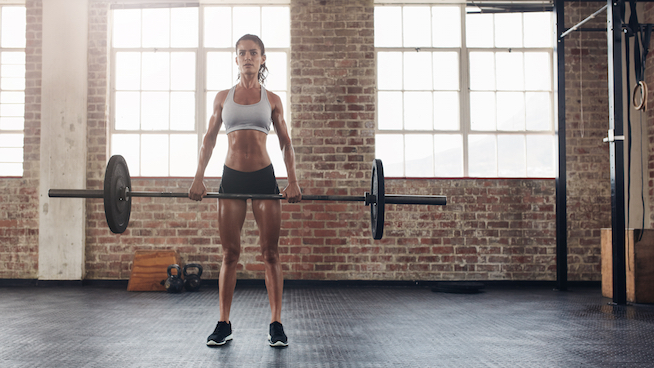
The right form cues can do wonders for an athlete’s Deadlift.
Stepping up to the bar with a plan in mind and a focus on executing a couple of techniques before and during the exercise can make the Deadlift both safer and more effective.
Bonvechio recommends that athletes set up from the top down instead of the bottom up when they’re deadlifting. He says, “A lot of athletes will sit into the low position with a rounded back and try to straighten their back once they grab the bar. I like to have guys get their back as straight as possible at the top and then hold that position as they go down to get the bar.”
To prevent your back from arching during the lift, it’s important to engage both your lats and your anterior core. “The abs keep the lower back in the same position throughout the lift. The lats works to keep the upper back in the same position throughout the lift. A combination of the two can keep your spine in one position. That’s a tough skill to learn, and most athletes haven’t been coached how to do that,” Bonvechio says.
RELATED: These Cues Will Shape-Up Your Deadlift Fast
To engage the lats, Bonvechio recommends two cues: make your arms as long as possible and “bend the bar around your shins.” The tension created engages the lats, which should help keep your upper-back rigid throughout the exercise. To engage the anterior core, Bonvechio recommends focusing on breathing. “I like to tell athletes to take all the air out of the room and put it in their stomach. That seems to work really well. Another one is, I’ll ask them what they’d do with their abs if they were about to get punched in the stomach, and that’s a pretty reflexive response.”
Different Strokes
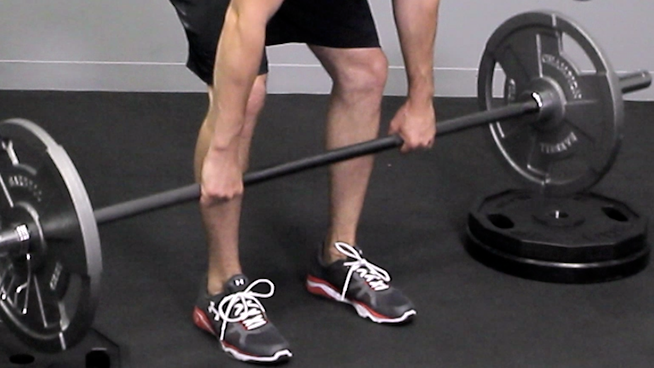
The word deadlift is typically associated with one specific exercise—a straight barbell, loaded with plates, being lifted directly off the floor. That does in fact describe a traditional Deadlift, but the truth is it might not work for everyone.
“No two people have the exact same build. Bone length, torso length, things like that—there’s no right variation for everyone. The lift needs to be catered to the trainee, not vice versa,” Gentilcore says.
Tall athletes in particular might benefit from using different variations. “Taller athletes are going to have a harder time getting their hips and hands in the right position with a standard barbell or a standard trap bar. So the first thing I’d do is elevate the plates on some sort of mat or block to get them in a good position,” Bonvechio says.
“You start getting guys who are 6-foot-4, 6-foot-5 and up, and it starts getting really hard for them to do anything from the floor. So you start getting into things like Rack Pulls, Block Pulls. You’re just trying to bring the barbell closer to their center of mass,” Gentilcore says.
Work with your strength and conditioning coach or trainer to help you find the type of Deadlift that best suits you.
RECOMMENDED FOR YOU
MOST POPULAR
My Back Hurts When I Deadlift. What Am I Doing Wrong?
The Deadlift.
It’s a powerhouse of an exercise that enhances almost every aspect of athletic performance. If you want to be bigger, stronger and faster, the Deadlift is an exercise that needs to be in your arsenal. However, mastering the form of the Deadlift takes time and practice. You’ll know pretty quickly if you deadlifted with poor form—for the next few days, your back will feel like it was on the wrong end of a sledgehammer. Deadlift-associated back pain is a common problem for many athletes, but it certainly shouldn’t turn you off from this excellent exercise for good. We will explain why your back might hurt after you deadlift and what you need to do to fix it.
The Posture Problem

We’ve detailed the prevalence of posture issues in previous articles. One of the biggest issues, among both athletes and non-athletes, is what’s known as excessive anterior pelvic tilt. It’s a result of a lifestyle that hunches us forward (think looking down at your phone or driving a car) and training that builds muscle imbalances.
RELATED: Read How Your Posture Can Ruin Your Performance
“Over time, athletes can adopt an exaggerated posture where they go into what’s called excessive anterior pelvic tilt; their pelvis is rolled forward and their lower back is arched pretty hard. What that does is it decreases hip motion and increases spinal motion. When they try to get into a hip hinge pattern like a Deadlift, they move more through their back than their hips,” says Tony Bonvechio, CSCS and owner of Bonvec Strength. Excessive anterior pelvic tilt is a big reason why so many athletes struggle to nail the Deadlift right off the bat.
Excessive anterior pelvic tilt also makes it difficult for an athlete to execute a proper hip hinge, the motion that’s required for a safe, strong Deadlift. “The Deadlift is a novel exercise. Most athletes lack the proper hip hinge motion to do the movement at first,” says Tony Gentilcore, CSCS and the owner of CORE in Brookline, Massachussets.
Additionally, many athletes have trouble learning how to brace their anterior core muscles during an exercise—a key component of deadlifting. “A lot of athletes who come in with excessive anterior pelvic tilt, they’re basically bracing through the backside of their body. They’re stabilizing the body by using the muscles of the lower back,” Bonvechio says. While this pattern might not be noticeable in many other exercises, the Deadlift makes it painfully apparent.”
RELATED: How to Fix Back Rounding When Deadlifting
The Sight of Soreness

What does a back-hurting Deadlift look like? Though it can take many forms, significant arching throughout the spine is a telltale sign. This form issue can result from a variety of factors, including muscle imbalances and lifting too much weight.
“A lot of athletes might start in a good position, but when they try to lift the weight, they round their back. The spine does not like to be loaded in a flexed position. It doesn’t like to be loaded when it’s rounded. Think of like a rainbow or a candy cane, that’s usually what you see,” Bonvechio says. “Their spine can’t stay in the same position throughout the entire lift so it rounds, because that’s the path of least resistance.”
RELATED: Fix The 10 Most Common Deadlift Technique Mistakes
Sounds painful, right? Young athletes also typically overload the Deadlift too early, setting themselves up for failure. “I think a lot of kids, particularly in high school, are anxious to brag or show off on social media and they’re just using too much weight. That doesn’t allow them the opportunity to learn how to execute the lift correctly with a weight they can actually handle,” Gentilcore says.
So you’ve got a ton of athletes lifting with poor form and using too much weight. That puts a lot of stress on their lower backs and spinal discs, which can lead to injuries such as herniated discs. No wonder the Deadlift seems to do a number on so many people’s backs.
Very few people are capable of nailing a straight barbell Deadlift from the floor on their first try. That’s why regressions are a key component to building a proper Deadlift.
One Step Back, Two Steps Forward

If you’re someone who frequently experiences back pain after you Deadlift, perhaps the best thing you can do is avoid the exercise for a while and do regressions in its place. Regressions are simpler, safer exercises that build the motor patterns and strength needed to execute a given exercise with proper form.
Dead Bugs can help you train your body to brace through your anterior core muscles. Bonvechio says, “Dead Bugs teach you how to get your ribcage down, how to get your pelvis in a neutral position and how to brace the right way. That’s a ground-based exercise, so it’s super simple.” Dead Bugs force you resist extension by bracing your core, which is exactly what you need when you deadlift.
RELATED: How to Do The Dead Bug, The Best Core Exercise You’ve Never Tried
Once you’ve mastered the Dead Bug, you can move on to standing exercises like Cable Pull-Throughs and Kettlebell Sumo Deadlifts. “Those exercises are also loaded a lot lighter than your typical barbell Deadlift, so even if an athlete doesn’t get it right the first time, the load is so light that it’s not detrimental,” Bonvechio says.
Once you’ve mastered these exercises, you can move on to variations like Rack Pulls and Trap Bar Deadlifts. These are a bit more user-friendly than straight bar Deadlifts from the ground. “A lot of times, a regression is a progression. If I can get an athlete to do the pattern pain-free, that’s progress,” Gentilcore says.
Right on Cue

The right form cues can do wonders for an athlete’s Deadlift.
Stepping up to the bar with a plan in mind and a focus on executing a couple of techniques before and during the exercise can make the Deadlift both safer and more effective.
Bonvechio recommends that athletes set up from the top down instead of the bottom up when they’re deadlifting. He says, “A lot of athletes will sit into the low position with a rounded back and try to straighten their back once they grab the bar. I like to have guys get their back as straight as possible at the top and then hold that position as they go down to get the bar.”
To prevent your back from arching during the lift, it’s important to engage both your lats and your anterior core. “The abs keep the lower back in the same position throughout the lift. The lats works to keep the upper back in the same position throughout the lift. A combination of the two can keep your spine in one position. That’s a tough skill to learn, and most athletes haven’t been coached how to do that,” Bonvechio says.
RELATED: These Cues Will Shape-Up Your Deadlift Fast
To engage the lats, Bonvechio recommends two cues: make your arms as long as possible and “bend the bar around your shins.” The tension created engages the lats, which should help keep your upper-back rigid throughout the exercise. To engage the anterior core, Bonvechio recommends focusing on breathing. “I like to tell athletes to take all the air out of the room and put it in their stomach. That seems to work really well. Another one is, I’ll ask them what they’d do with their abs if they were about to get punched in the stomach, and that’s a pretty reflexive response.”
Different Strokes

The word deadlift is typically associated with one specific exercise—a straight barbell, loaded with plates, being lifted directly off the floor. That does in fact describe a traditional Deadlift, but the truth is it might not work for everyone.
“No two people have the exact same build. Bone length, torso length, things like that—there’s no right variation for everyone. The lift needs to be catered to the trainee, not vice versa,” Gentilcore says.
Tall athletes in particular might benefit from using different variations. “Taller athletes are going to have a harder time getting their hips and hands in the right position with a standard barbell or a standard trap bar. So the first thing I’d do is elevate the plates on some sort of mat or block to get them in a good position,” Bonvechio says.
“You start getting guys who are 6-foot-4, 6-foot-5 and up, and it starts getting really hard for them to do anything from the floor. So you start getting into things like Rack Pulls, Block Pulls. You’re just trying to bring the barbell closer to their center of mass,” Gentilcore says.
Work with your strength and conditioning coach or trainer to help you find the type of Deadlift that best suits you.










